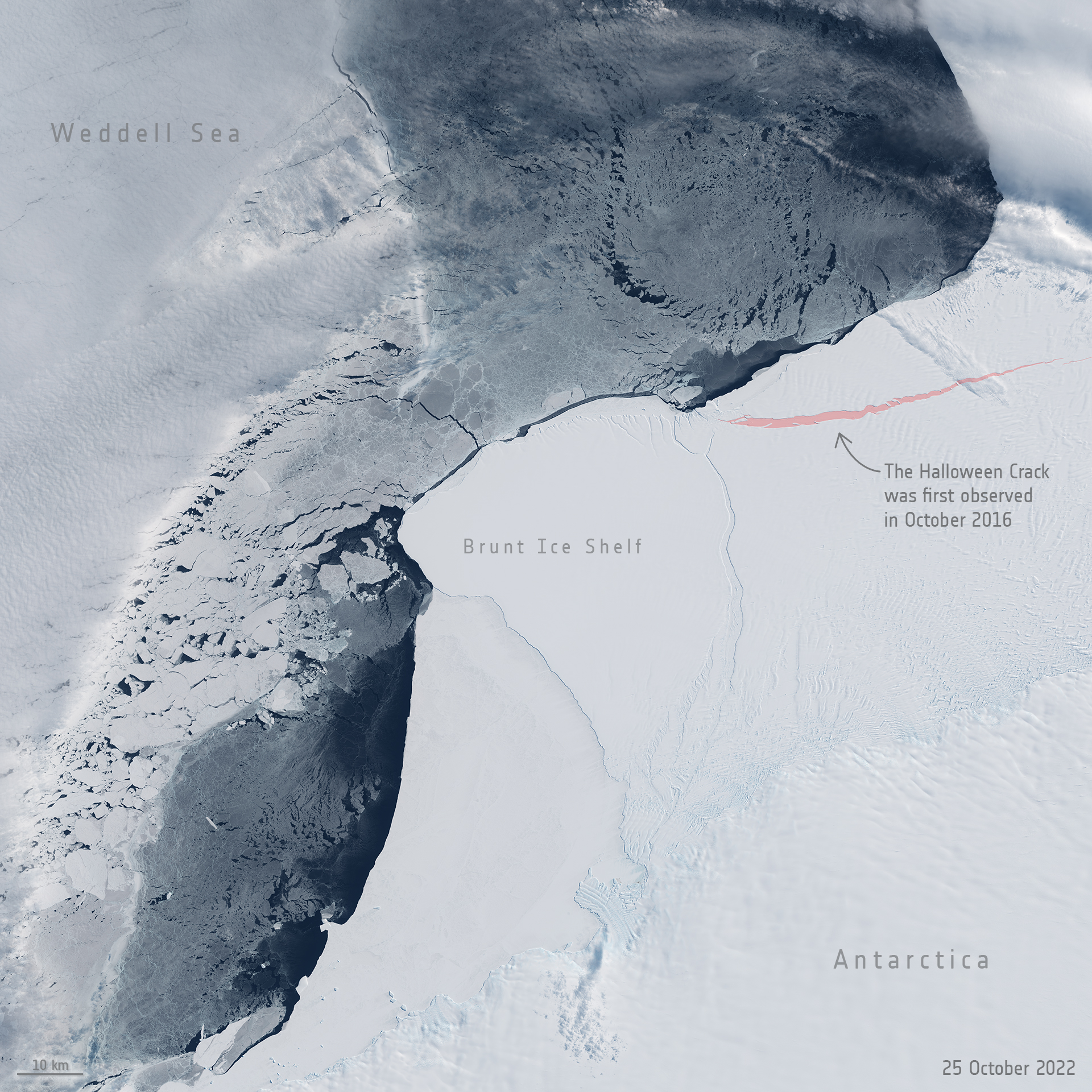Satellite peers at a creepy iceberg's 'Halloween crack' (photo)
The iceberg tip is 'hanging by a thread' due to ongoing climate change in Antarctica.

A spooky "Halloween crack" looms beside an Antarctic iceberg shelf that's "hanging by a thread," new satellite imagery shows.
The crevice itself is stable, according to the European Space Agency (ESA), but it's the nearby tip of Antarctica's Brunt Ice Shelf that causes concern as the southernmost continent continues to warm due to climate change.
Only a slender thread of ice about one-third of a mile (600 meters) long is holding the tip to the rest of the shelf, new space observations show.
"If and when this potential rupture point finally gives way, it is expected to spawn a huge iceberg about 1750 square kilometers [675 square miles]," ESA officials wrote Monday (Oct. 31), "which is over five times bigger than the size of Malta." (Malta is about one-tenth the size of Rhode Island, the smallest U.S. state.)
In photos: Giant crack frees a massive iceberg in Antarctica
The fresh footage from the Sentinel-2 satellite mission, part of Europe's Copernicus Earth-observation program, may help with forecasting the associated sea rise on Earth if that precarious tip sloughs into the nearby Weddell Sea.
It's not so much the threat of a new iceberg that is the issue, as ice shelves float, ESA officials said. But these shelves do slow down the flow of land ice into the ocean.
Get the Space.com Newsletter
Breaking space news, the latest updates on rocket launches, skywatching events and more!
"Owing to climate change, Antarctica’s ice shelves are weakening, leading to greater risks of more land ice ending up in the oceans and thereby adding to sea-level rise, something arguably more frightening than Halloween," agency officials wrote.
Besides the spooky situation, the reason the "Halloween Crack" is so named is its discovery date: Oct. 31, 2016. It resides in a zone colorfully called the McDonald Ice Rumples, referring to where the bottom of the ice shelf is attached to the seabed below. Since the shelf is grounded, that also slows down ice loss, ESA added.
The study of this iceberg is part of a larger set of satellite observations of Antarctica, which is quite remote but still within reach of satellites, which can observe "changes in ice dynamics, air and ocean temperatures," ESA stated.
Elizabeth Howell is the co-author of "Why Am I Taller?" (ECW Press, 2022; with Canadian astronaut Dave Williams), a book about space medicine. Follow her on Twitter @howellspace. Follow us on Twitter @Spacedotcom or Facebook.
Join our Space Forums to keep talking space on the latest missions, night sky and more! And if you have a news tip, correction or comment, let us know at: community@space.com.

Elizabeth Howell (she/her), Ph.D., was a staff writer in the spaceflight channel between 2022 and 2024 specializing in Canadian space news. She was contributing writer for Space.com for 10 years from 2012 to 2024. Elizabeth's reporting includes multiple exclusives with the White House, leading world coverage about a lost-and-found space tomato on the International Space Station, witnessing five human spaceflight launches on two continents, flying parabolic, working inside a spacesuit, and participating in a simulated Mars mission. Her latest book, "Why Am I Taller?" (ECW Press, 2022) is co-written with astronaut Dave Williams.









